Title: Understanding Synovial Joint Movements and Types
Movements at Synovial Joints
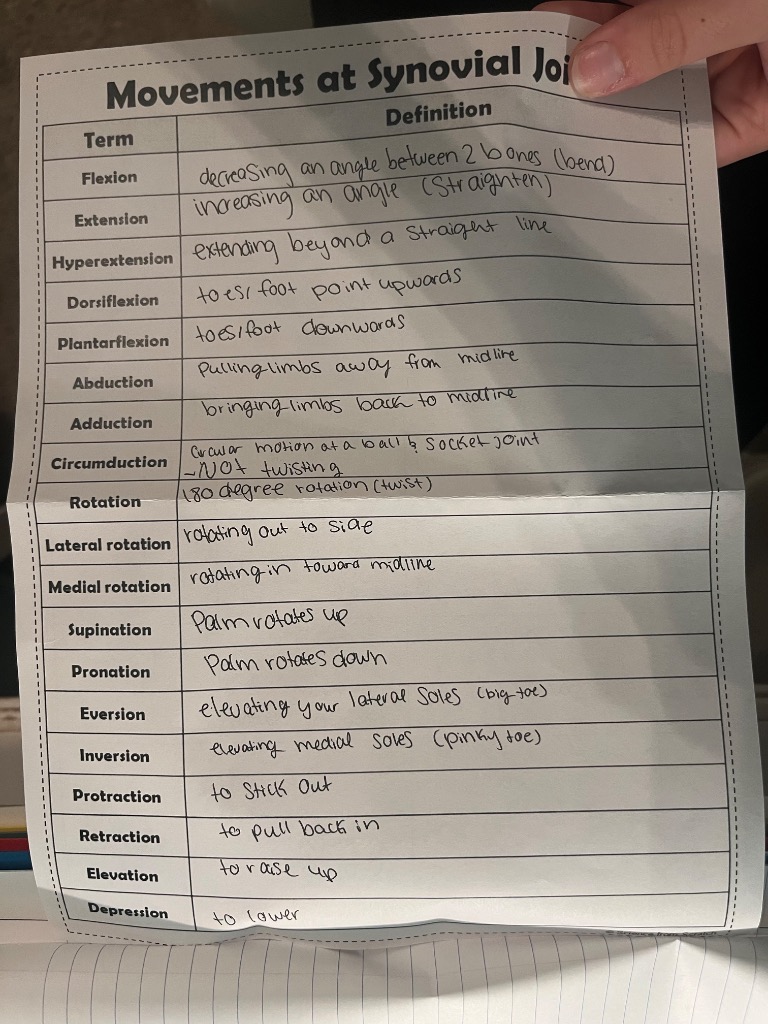
Notes on Definitions of Joint Movements
| Term | Definition |
|---|---|
| Flexion | Decreasing the angle between two bones (bend). This movement is critical in many daily activities, such as bending the elbow to lift an object. |
| Extension | Increasing an angle between two bones (straightening). Essential for movements like straightening the knee after a squat. |
| Hyperextension | Extending beyond a straight line. Important in activities like backbends in yoga, but can be risky if done excessively. |
| Dorsiflexion | Toes/foot point upwards. This is a crucial movement when walking or running to allow the foot to clear the ground. |
| Plantarflexion | Toes/foot point downwards. Common in actions like standing on tiptoes or pushing off while running. |
| Abduction | Pulling limbs away from the midline of the body. This movement is often observed in exercises like lateral raises. |
| Adduction | Bringing limbs back to the midline. Important for movements such as bringing arms back to the sides after lateral raises. |
| Circumduction | Circular motion at ball and socket joint, NOT twisting. This movement can be seen in shoulder rotations during activities like throwing. |
| Rotation | 180-degree rotation (twist). This is common in sports and daily activities that require twisting the torso. |
| Lateral rotation | Rotating out to the side. This movement assists in actions such as kicking a soccer ball. |
| Medial rotation | Rotating in toward the midline. Important for movements like cross-body stretches. |
| Supination | Palm rotates up. This position is essential for holding objects firmly in the hand. |
| Pronation | Palm rotates down. Crucial for certain grips and movements in sports like tennis. |
| Eversion | Elevating lateral soles (big toe). This movement is involved in stabilizing the foot during walking or running. |
| Inversion | Elevating medial soles (pinky toe). This action helps maintain balance and control when navigating uneven surfaces. |
| Protraction | To stick out. Commonly observed when pushing the shoulders forward, such as during a push-up. |
| Retraction | To pull back in. This movement engages the muscles of the upper back, helping with posture and shoulder stability. |
| Elevation | To raise up. Seen in movements like shrugging the shoulders or lifting arms overhead. |
| Depression | To lower. This action is common in returning to a resting position after lifting. |
Additional Thoughts
Understanding these movements is essential for anyone involved in physical therapy, sports science, or fitness training, as they form the basis for assessing movement patterns, developing rehabilitation protocols, and enhancing athletic performance. Recognizing these movements can also help prevent injuries during physical activities.
Extended readings:
6 Types of Synovial Joints
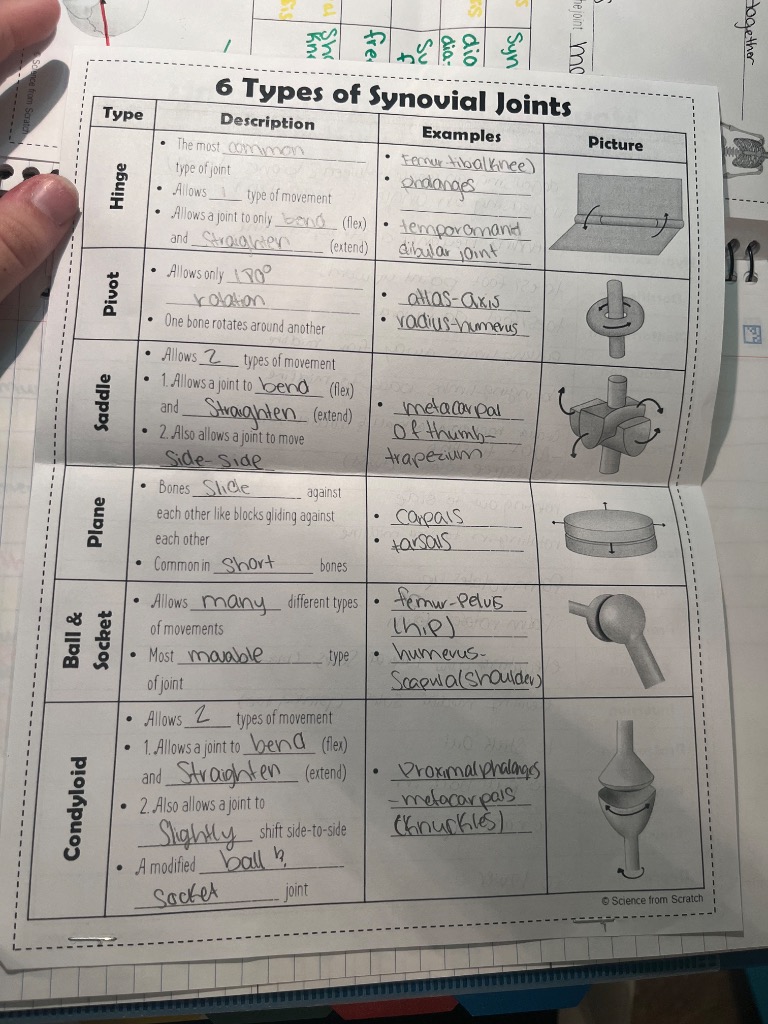
Types of Synovial Joints Table
| Type | Description | Examples | Picture |
|---|---|---|---|
| Hinge | - The most common type of joint | - Femoral-tibial (knee) | |
| - Allows a joint to only bend (flex) and straighten (extend) | - Temporomandibular (jaw) | ||
| - Elbow | |||
| Pivot | - Allows only 1° of rotation | - Atlas-Axis | |
| - One bone rotates around another | - Radius-Humerus | ||
| Saddle | - Allows 2 types of movement | - Metacarpal of thumb | |
| 1. Allows a joint to bend (flex) and straighten (extend) | - Trapezium | ||
| 2. Also allows a joint to move side-to-side | |||
| Plane | - Bones slide against each other | - Short bones | |
| - Common in short bones | |||
| Ball & Socket | - Allows many different types of movements | - Femur-Pelvis (hip) | |
| - Most movable type of joint | - Humerus-Scapula (shoulder) | ||
| Condyloid | - Allows 2 types of movement | - Proximal phalanges | |
| 1. Allows a joint to bend (flex) and straighten (extend) | - Metacarpals (knuckles) | ||
| 2. Also allows a joint to shift side-to-side | |||
| - A modified ball & socket joint |
Notes on Synovial Joints
-
Hinge Joints: These are crucial for movements like bending and extending, similar to the hinge of a door. They are vital for the movement of limbs.
-
Pivot Joints: They allow rotational movement, which is essential for actions such as shaking the head "no" or turning the wrist.
-
Saddle Joints: These joints are unique in their ability to allow movement in two planes, making them particularly useful for the thumb's range of motion, enhancing grip and manipulation.
-
Plane Joints: These joints allow for limited movement, primarily sliding, and are commonly found in areas like the wrists and ankles, contributing to flexibility and coordination.
-
Ball & Socket Joints: Known for their versatility, these joints permit a wide range of motion in multiple directions, making them essential for limbs like shoulders and hips.
-
Condyloid Joints: These joints facilitate an extensive range of movement while also allowing some side-to-side motion, which is particularly useful for finger and wrist flexibility.
Extended readings:
Joints Chart Notes
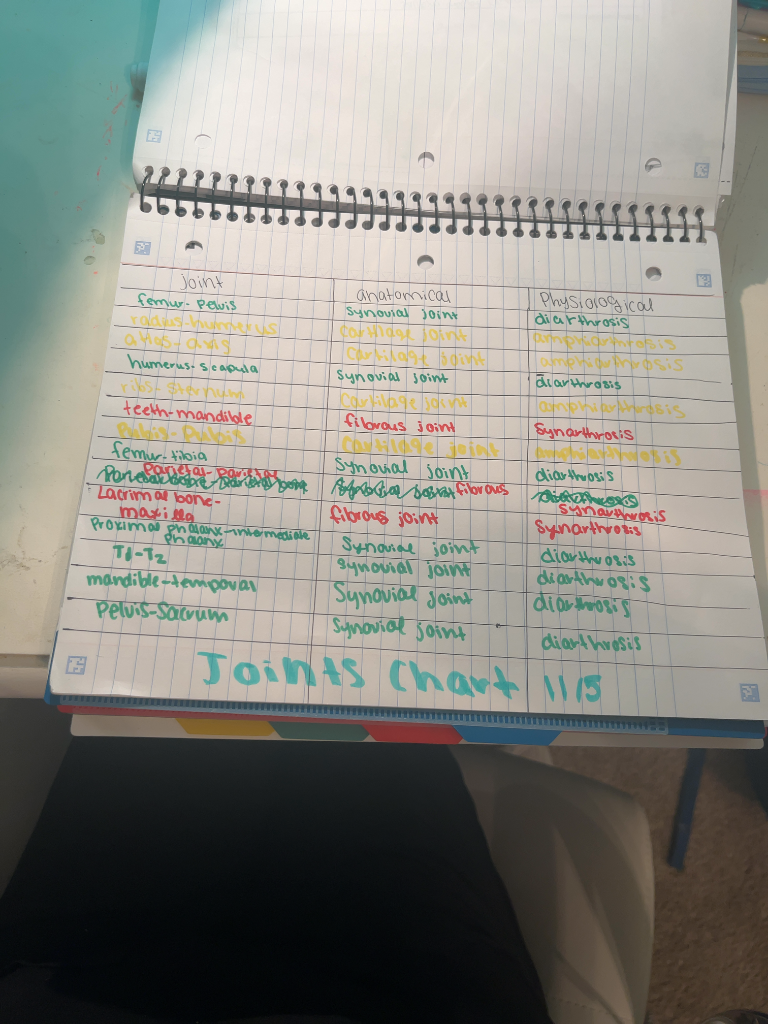
Overview
The image presents a chart categorizing various joints based on their anatomical and physiological classifications. Understanding these classifications is crucial for fields like anatomy, kinesiology, and physical therapy since it helps clarify the functional roles and movements of different joints.
Joints Classification Table
| Joint | Anatomical Classification | Physiological Classification |
|---|---|---|
| femur - pelvis | synovial joint | diarthrosis |
| radius - humerus | synovial joint | diarthrosis |
| atlas - axis | synovial joint | diarthrosis |
| humerus - scapula | synovial joint | diarthrosis |
| ribs - sternum | cartilaginous joint | synarthrosis |
| teeth - mandible | fibrous joint | synarthrosis |
| pelvis - pubis | cartilaginous joint | symphysis |
| femur - tibia | synovial joint | diarthrosis |
| proximal phalanx - intermediate phalanx | synovial joint | diarthrosis |
| T1 - T2 | cartilaginous joint | symphyses |
| mandible - temporal | synovial joint | diarthrosis |
| pelvis - sacrum | synovial joint | diarthrosis |
Detailed Notes
-
Understanding Joint Types:
- Synovial Joints: These joints allow for a wide range of movement and are characterized by a joint capsule that contains synovial fluid, lubricating the joint.
- Fibrous Joints: These joints are connected by dense connective tissue and allow for very little movement (e.g., teeth in their sockets).
- Cartilaginous Joints: These join two bones together with cartilage and allow limited movement (e.g., the pelvis).
-
Physiological Classification:
- Diarthrosis: A freely movable joint, which is crucial for a wide range of activities and exercise. Recognizing the specific type of diarthrosis can help in understanding motion limits and potential for injury.
- Synarthrosis: These joints are immovable and provide stability. Knowing the location of synarthroses can assist in designing routines that focus on joint protection.
-
Applications in Healthcare and Fitness:
- In physical therapy, identifying the type of joint can aid in rehabilitation programs by targeting specific movements to strengthen the surrounding muscles while considering joint limitations.
- Understanding these classifications can enhance athletic performance by tailoring training regimens that utilize the joints effectively while minimizing injury risk.
Overall, this chart serves as a fundamental resource for anyone studying human anatomy, providing essential insights into how different joints function and their role in movement.
Extended readings:
Discussion on Leadership and Machiavelli
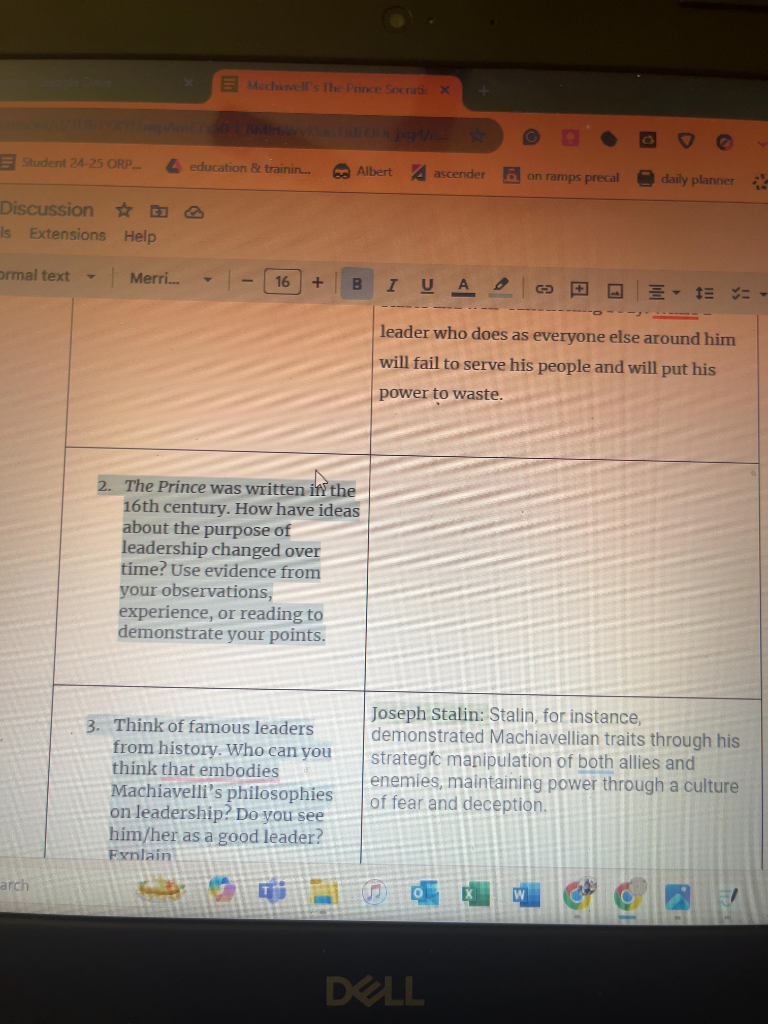
Notes
1. The Impact of Leadership Concepts Over Time
- Overview: The evolving notions of leadership, particularly since the 16th century when Machiavelli wrote "The Prince," have shifted dramatically.
- Considerations: Modern leadership now often emphasizes collaboration, empathy, and inclusiveness, contrasting with Machiavelli's view that prioritizes power and manipulation.
- Influence of Context: Economic, political, and social contexts shape what is regarded as effective leadership.
2. Joseph Stalin as a Machiavellian Leader
- Analysis: Joseph Stalin is invoked as a historic example of a leader exhibiting Machiavellian traits.
- Strategies: His political strategies included strategic manipulation of both allies and enemies, exemplifying cunning, deceit, and a ruthless pursuit of power.
- Cultural Impact: Maintaining authority through fear and a culture of deception illustrates the darker aspects of leadership that Machiavelli described.
3. Notable Machiavellian Leaders
- Understanding Machiavellian Traits: Identify leaders who mirror Machiavelli's philosophies, analyzing their methods and effectiveness.
- Criteria for Evaluation: Consider whether these leaders' approaches yield positive or negative outcomes, and their moral implications.
- Examples:
- Historical Figures: Additional leaders in history could be explored, such as Niccolò Machiavelli himself, or figures like Julius Caesar or Queen Elizabeth I, to analyze differing facets of power and leadership.
Summary
This discussion reflects on the evolution of leadership concepts from Machiavelli's era to the present, exemplified through the analysis of historical figures like Joseph Stalin. It invites critical thought on whether Machiavellian traits can be justified in leaders based on their outcomes, encouraging a broader understanding of leadership dynamics.
Extended readings:
Notes on Machiavelli's "The Prince" Discussion
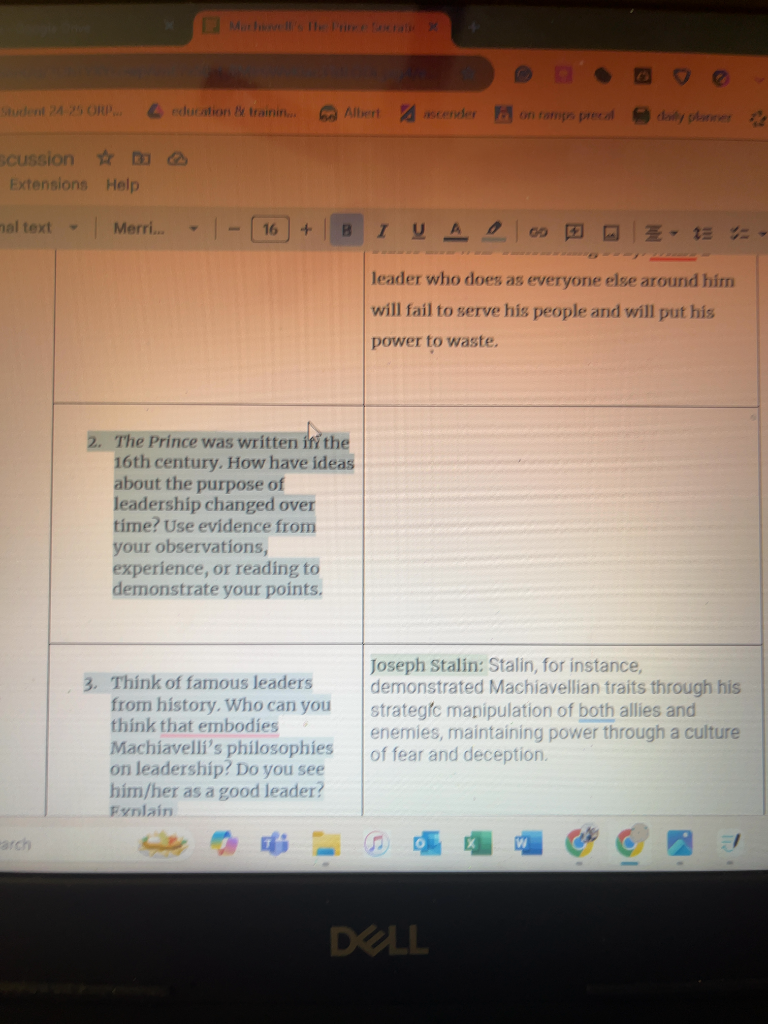
-
Purpose of Leadership over Time:
- The image poses a question about the evolution of leadership concepts since the 16th century, particularly as outlined in Machiavelli's "The Prince."
- Leadership styles may have shifted from authoritarian to more democratic approaches in modern contexts. For instance, contemporary leaders often emphasize collaboration and transparency rather than solely exercising power and fear. This reflects societal changes in values towards inclusivity and ethical governance.
-
Example of a Historical Leader: Joseph Stalin:
- Machiavellian Traits: The notes mention that Joseph Stalin showcased traits typical of Machiavelli's philosophies. His strategies involved manipulation to maintain power and control, which aligns with Machiavelli's views on the necessity for pragmatic, sometimes unscrupulous, leadership.
- Use of Fear and Deception: Stalin’s governance created a culture of fear, where loyalty was enforced through intimidation and repression. This serves as a vivid example of Machiavelli’s assertion that the ends often justify the means in maintaining power.
- Assessment of Leadership: While Stalin might be seen as effective in consolidating power, the moral implications of his methods lead to questions about whether such leadership is acceptable or sustainable in modern times. Discussions around leaders often balance effectiveness against ethical standards.
-
Table of Discussion Points:
| Question/Topic | Notes |
|---|---|
| How have ideas about the purpose of leadership changed over time? | Shift from authoritarian to democratic styles; focus on collaboration and transparency. |
| Famous Leaders and Machiavelli's Philosophies: | Example: Joseph Stalin—Machiavellian manipulation of fear and deceit for power retention. |
| Do you see him/her as a good leader? | Effectiveness vs. ethical implications; sustainability of leadership practices in modern context. |
These notes provide context for understanding Machiavelli's influence on leadership theories and how historical examples illustrate these concepts.
Extended readings:
Notes on Machiavelli's Perspectives on Morality and Leadership
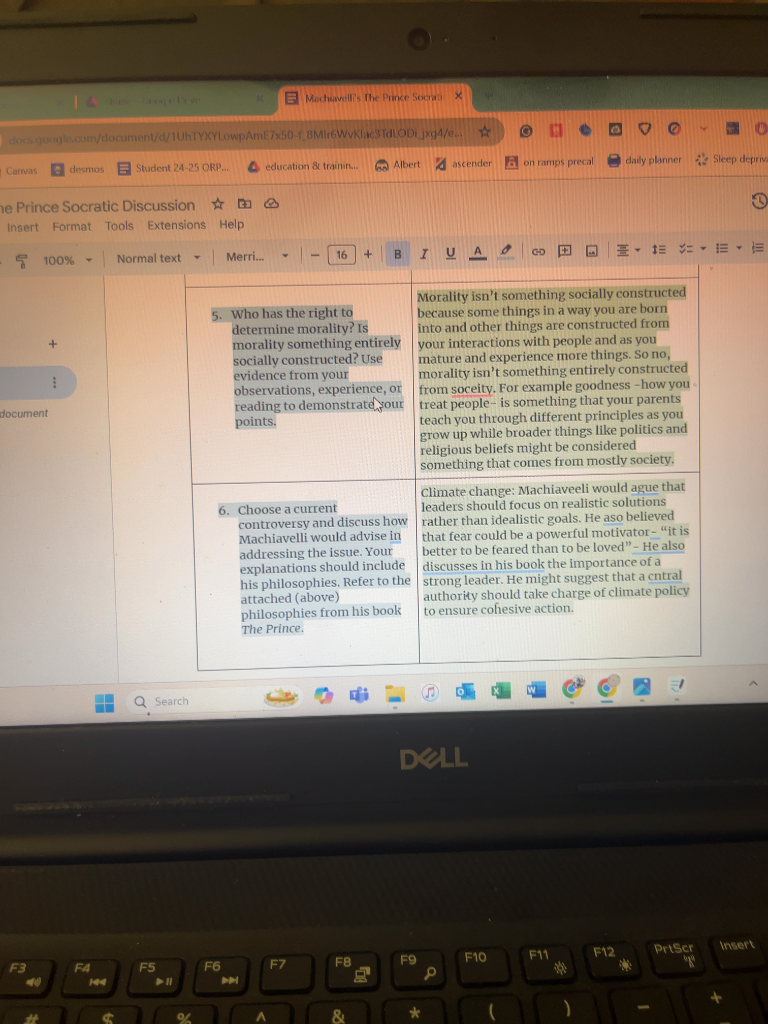
Key Concepts
1. Determining Morality
- Who has the right to determine morality?
- Morality is influenced by social constructs and individual experiences. Traditionally, it may seem that society dictates moral standards, but personal observations and interactions also shape one’s moral compass.
- Thoughts: The role of community versus individual insight could spark debates on subjective versus objective morality. Are societal norms always just, or can personal experience lead to a more equitable morality?
2. Machiavelli's Philosophy on Leadership
- Choose a current controversy and Machiavelli's advice:
- Machiavelli might suggest pragmatism over idealism in leadership, focusing on realistic goals. He emphasized that being feared can be more effective than being loved, as fear can be a strong motivator.
- Thoughts: This raises ethical questions about governance. Should leaders prioritize control and order at the potential cost of liberty and trust? Historical examples could illustrate the dangers or successes of this approach.
Summary Table of Information
| Task | Description |
|---|---|
| Who determines morality? | Morality is partially socially constructed; individual experience plays a significant role. |
| Machiavelli on leadership | Advocates for pragmatic leadership; suggests that fear can be a stronger motivational tool than love. |
Additional Information
- Machiavelli's "The Prince": This seminal work discusses the qualities of a successful ruler and the political strategies necessary for maintaining power. Machiavelli's insights continue to inform modern political theory and debates on ethical leadership.
- Contemporary Application: In modern contexts, leaders face challenges such as climate change and social justice. Machiavellian principles might guide decision-making, emphasizing the need for strong, decisive leadership to effectively tackle complex issues.
Socratic Discussion on Machiavelli
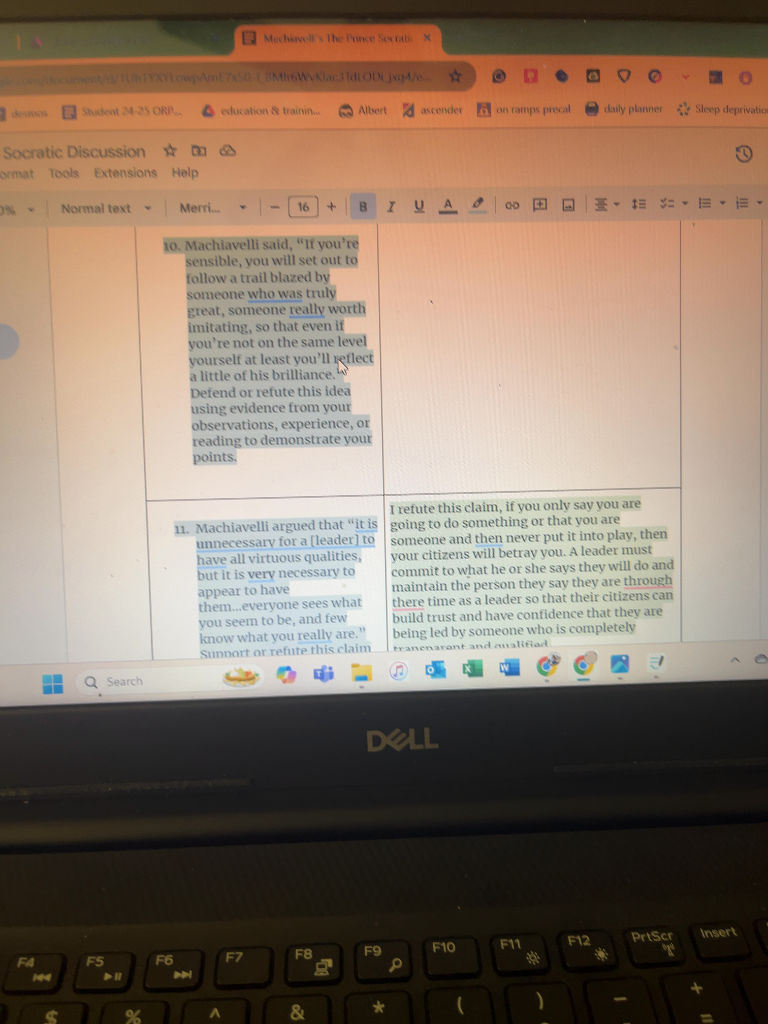
Key Quotes and Ideas:
-
Machiavelli's Perspective on Leadership:
- Quote: “If you’re sensible, you will set out to follow a trail blazed by someone who was truly great, someone really worth imitating...”
- Thoughts: This emphasizes the importance of learning from exemplary leaders and their methods. Imitation of successful traits can propel individuals toward greatness.
- Additional Info: Machiavelli suggests that recognizing and adopting effective behaviors can provide a strategic advantage in governance or personal achievements.
- Quote: “If you’re sensible, you will set out to follow a trail blazed by someone who was truly great, someone really worth imitating...”
-
Virtue vs. Appearance in Leadership:
- Quote: “...it is unnecessary for a [leader] to have all virtuous qualities, but it is very necessary to appear to have them...”
- Thoughts: This acknowledges a pragmatic approach to leadership. Perception can often outweigh reality in politics.
- Additional Info: Leaders may benefit from portraying qualities that inspire trust and respect, even if they do not embody all of them. This ties into notions of political realism where actions can sometimes deviate from ethics for stability.
- Quote: “...it is unnecessary for a [leader] to have all virtuous qualities, but it is very necessary to appear to have them...”
Summary of Discussion Points:
-
Imitation of Great Leaders:
- Importance of learning from historical figures.
- The balance between personal authenticity and strategic imitation.
-
Perception vs. Reality in Leadership:
- Necessity of maintaining a virtuous appearance.
- Implications for citizen loyalty and trust in governance.
Additional Observations:
- The discussion reflects ongoing themes in leadership studies, particularly concerning the effectiveness versus ethicality of leadership approaches.
- Machiavelli’s ideas are not just historical; they may still be relevant in contemporary leadership scenarios across various sectors, including politics and business.
Table Extracted from the Image:
| Quote | Concept | Reflection |
|---|---|---|
| “If you’re sensible, you will set out to follow a trail blazed by someone who was truly great...” | Imitation in Leadership | Learning from effective leaders can enhance one’s own leadership style. |
| “...it is unnecessary for a [leader] to have all virtuous qualities, but it is very necessary...” | Appearance vs. Reality | Leaders must project certain virtues to maintain trust and legitimacy. |
Extended readings:
Socratic Discussion Notes
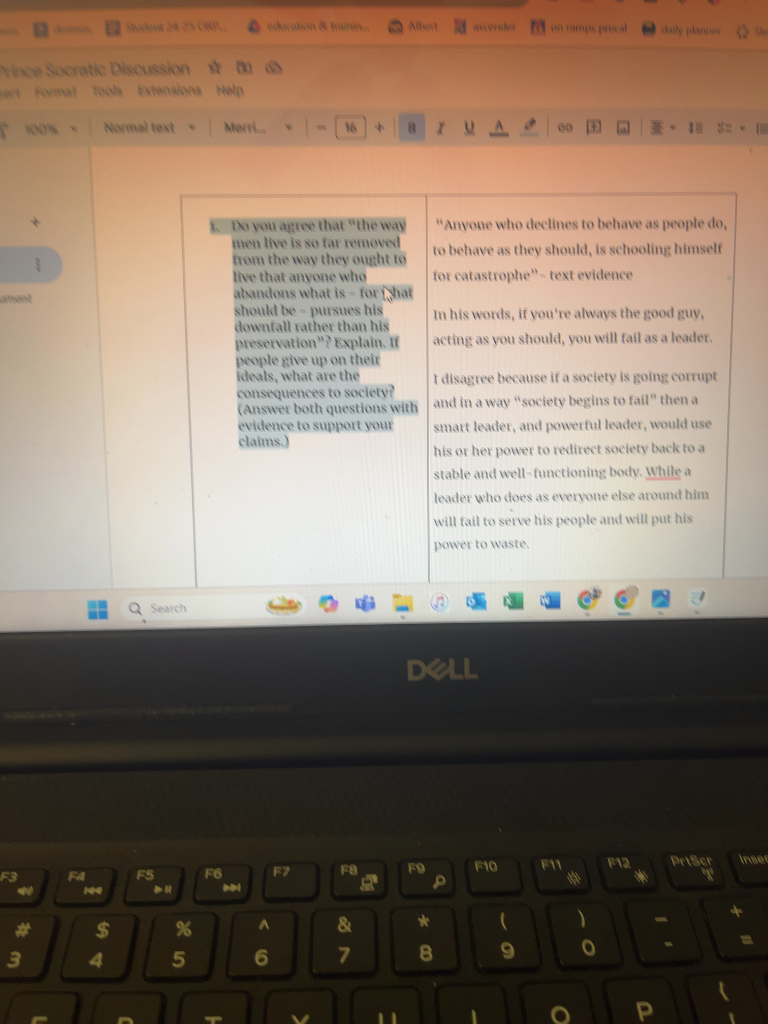
Key Question
- Do you agree with the statement about how people live and their ideals?
- This probes the disconnect between what individuals aspire to be and their actual behavior. Engaging with this question encourages exploration of societal norms and personal values.
Consequences of Abandoning Ideals
- If people give up on their ideals, what are the societal consequences?
- Individuals who abandon their ideals may contribute to societal decay. A decline in ideals can lead to corruption, unethical behavior, and a lack of trust within communities.
Text Evidence
- "Anyone who declines to behave as people do, to behave as they should, is schooling himself for catastrophe."
- This suggests that failing to adhere to social norms or personal ethics can lead to negative outcomes, not only for the individual but for society as a whole.
Leadership Dynamics
- Importance of Ethical Leadership
- The text highlights that the role of a leader is multifaceted. A good leader should not only lead by example but also be responsive to societal decay. Ignoring these dynamics may result in a failure to lead effectively.
- Reference to Power and Responsibility
- A leader's responsibility to utilize their position wisely is crucial. If they do not actively work to correct societal issues, they risk becoming ineffective.
Additional Reflection
- The Role of Society in Shaping Actions
- Society plays a significant role in shaping individual behavior. When societal standards deteriorate, individuals may feel justified in abandoning their ideals.
- Potential for Redemption Through Leadership
- A strong leader can influence societal norms positively. The dialogue invites an exploration of the characteristics that define a "good leader" and the implications of their actions on the community.
Conclusion
- The discussion raises important questions about ethics, leadership, and societal expectations, encouraging a reflective approach to how ideals shape actions and the broader implications for society. Emphasizing the interconnectedness of individual choices and community outcomes can lead to a more holistic understanding of moral responsibility.
Extended readings:
Notes on the Image Content
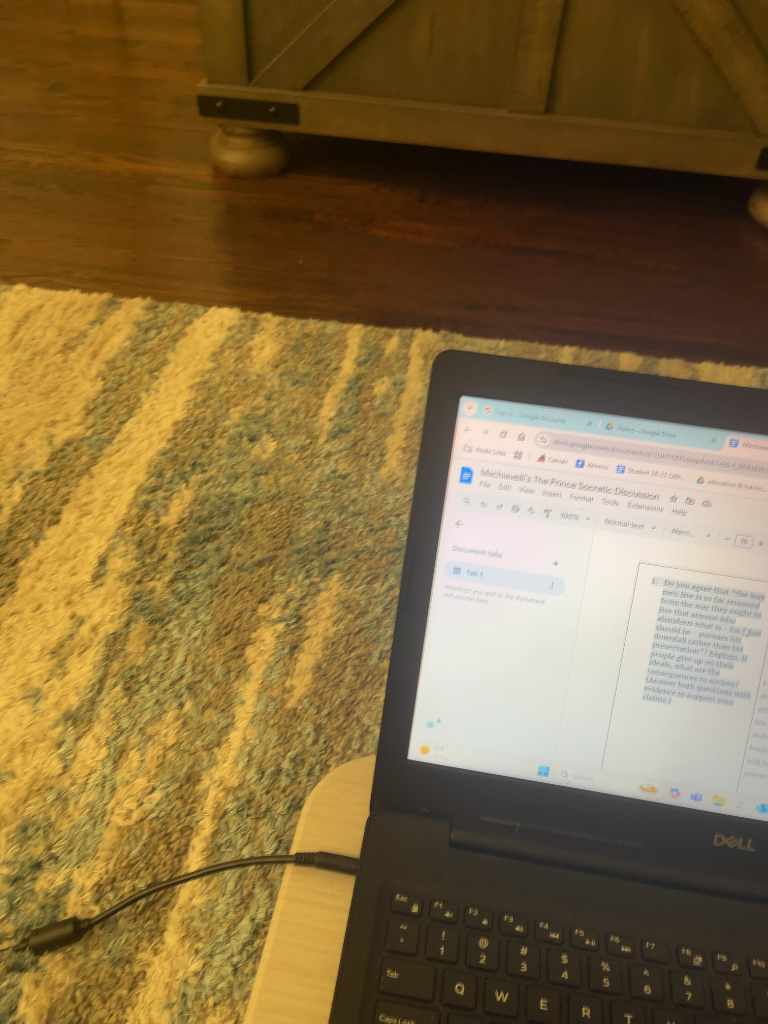
-
Document Title: The Prince Socratic Discussion
- This document appears to be part of a collaborative effort, likely targeted at analyzing or discussing Niccolò Machiavelli's "The Prince." A Socratic Discussion typically emphasizes critical thinking and dialogue, aiming to explore philosophical questions, which is essential when discussing the ethics of leadership traits associated with Machiavelli.
-
Content Overview
- The visible text refers to engaging with questions such as:
- "Do you agree that using fear can be a valid strategy for a ruler?"
- This reflects Machiavelli’s controversial stance on the use of fear versus love in governance. The implications here could encourage debate on the moral dimensions of leadership—whether ethical considerations should guide a leader's actions or if pragmatic strategies are justified regardless of morality.
- "Do you agree that using fear can be a valid strategy for a ruler?"
- The visible text refers to engaging with questions such as:
-
Collaboration Tools
- The mention of "Document table" suggests there may be structured discussion points or a summary table included in the document. This could potentially include arguments for and against Machiavelli's ideas, offering diverse viewpoints from different contributors, which can enrich the discussion.
Summary Table (Extracted from Contextual Clues)
| Discussion Point | Arguments For | Arguments Against |
|---|---|---|
| Use of Fear in Leadership | Can establish control and order | Can foster distrust and rebellion |
| Morality in Governance | Machiavelli's perspective is pragmatic | Ethical leadership builds longer-term loyalty |
| Leadership Styles | Allows flexibility in decision-making | May encourage tyranny and oppressive regimes |
-
Thoughts on Team Collaboration
- Engaging with Machiavelli’s ideas through a Socratic lens can foster critical discussions. Utilizing collaborative tools such as Google Docs promotes the sharing of diverse perspectives, making the analysis richer and more comprehensive.
-
Connection to Previous Notes
- The ongoing exploration of leadership principles, especially in the context of Machiavelli’s philosophy versus more modern ethical frameworks, aligns with earlier discussions on leadership and morality, enhancing the understanding of how leadership traits evolve and are perceived across different time periods and contexts.
Extended readings:
Machiavelli's The Prince Socratic Discussion
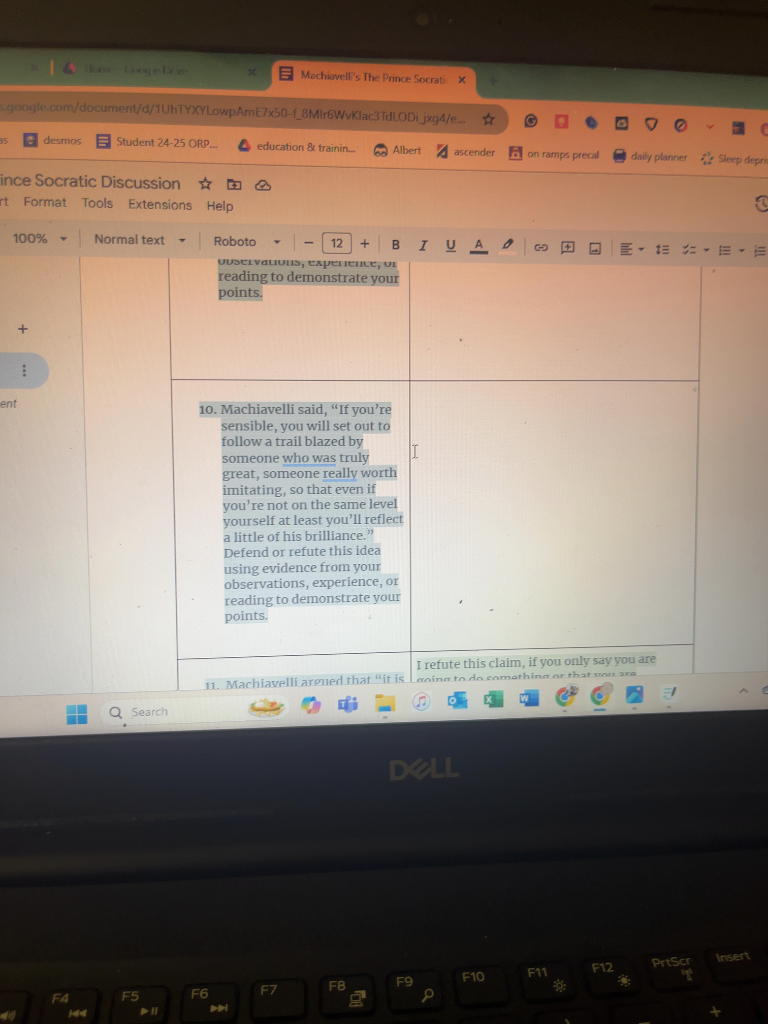
Key Concepts:
-
Machiavelli's Quote:
- "If you’re sensible, you will set out to follow a trail blazed by someone who was truly great..."
- Thoughts/Ideas: This suggests the importance of learning from established leaders and thinkers. Imitation can be a powerful tool for growth and understanding. It implies that even if one does not achieve greatness, the influence of those who have done so can have a profound impact.
- "If you’re sensible, you will set out to follow a trail blazed by someone who was truly great..."
-
Defense/Refutation of Machiavelli’s Idea:
- Example Response: "I refute this claim, if you only say you are going to do something or that you are..."
- Thoughts/Ideas: This response could provide a critical viewpoint on the limitations of imitation. It suggests that merely following or mimicking others without genuine understanding or intent may not lead to true success or brilliance. This raises questions about authenticity in leadership and the nature of true innovation.
- Example Response: "I refute this claim, if you only say you are going to do something or that you are..."
Original Information (Table Format):
| # | Content |
|---|---|
| 10 | Machiavelli said, "If you’re sensible, you will set out to follow a trail blazed by someone who was truly great, someone really worth imitating, so that even if you’re not on the same level yourself, at least you’ll reflect a little of his brilliance." |
| Defend or refute this idea using evidence from your observations, experience, or reading to demonstrate your points. | |
| 11 | Machiavelli argued that "it is..." |
Additional Context:
- The discussion is situated in a Socratic context, suggesting a focus on dialogue and exploration of ideas rather than rote answers. This method encourages critical thinking and engagement with Machiavelli's texts in a modern context, relating to themes such as leadership, morality, and the role of imitation in success.
Extended readings:
Notes on Machiavelli's Perspectives
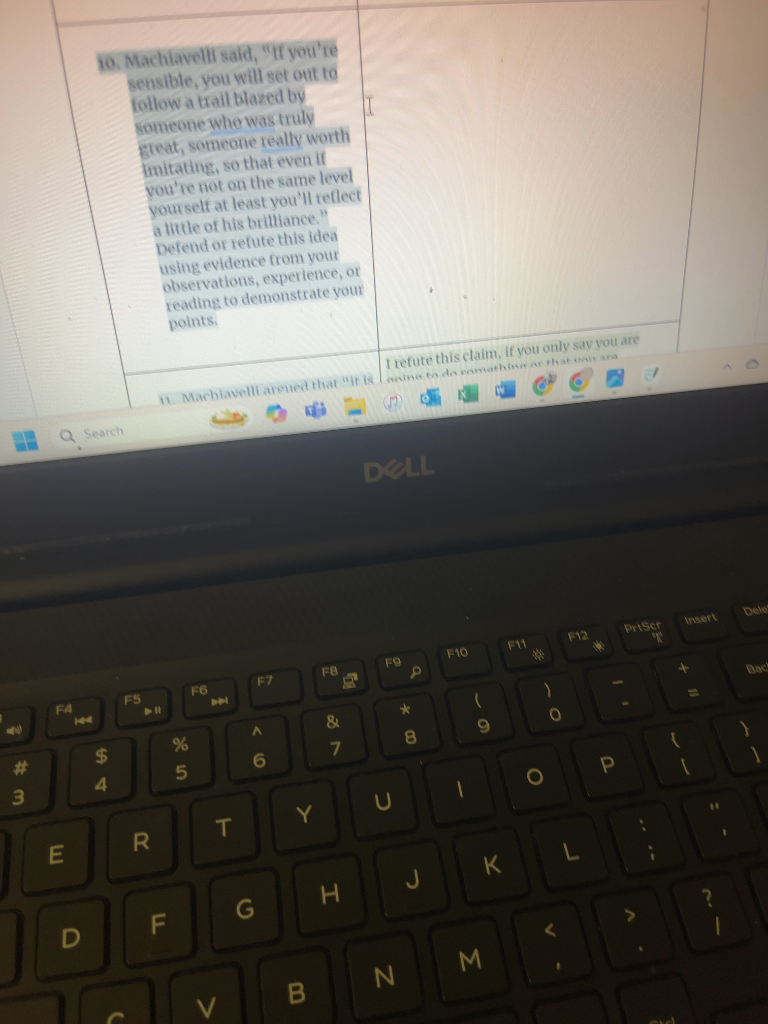
-
Quote Analysis
- Machiavelli states, "If you’re sensible, you will set out to follow a trail blazed by someone who was truly great, someone really worth imitating..."
- Thoughts: This highlights the importance of learning from exemplary figures in history. It suggests that to achieve greatness, one should model their actions after those who have excelled, thereby increasing the chances of success.
- Additional Information: Imitation is a recognized part of skill development, and looking up to established leaders can provide practical frameworks and lessons in various fields.
- Machiavelli states, "If you’re sensible, you will set out to follow a trail blazed by someone who was truly great, someone really worth imitating..."
-
Defending vs. Refuting Ideas
- Machiavelli encourages individuals to defend or refute his ideas using personal observations, experiences, or readings.
- Thoughts: This offers a pathway for personal reflection and critical thinking. Engaging with Machiavelli’s ideas can foster a deeper understanding of leadership dynamics and personal values.
- Additional Information: This approach emphasizes the value of discourse and analysis in philosophy and leadership studies, encouraging individuals to adapt Machiavelli's thoughts to their own context.
- Machiavelli encourages individuals to defend or refute his ideas using personal observations, experiences, or readings.
-
General Leadership Insight
- Machiavelli's ideas reflect a pragmatic approach to leadership that values results over appearances.
- Thoughts: While ethical considerations are important, Machiavelli points out that leaders may need to make difficult decisions. The implication is that showing virtue can sometimes be less important than actual effectiveness.
- Additional Information: His perspectives can prompt discussions on the balance between ethical leadership and results-driven management, relevant in modern business and politics.
- Machiavelli's ideas reflect a pragmatic approach to leadership that values results over appearances.
Summary of Key Points
- Imitation of successful figures is essential for growth.
- Engaging critically with ideas leads to personal and leadership development.
- Pragmatism in leadership and the tension between ethics and effectiveness are significant themes in Machiavelli's work.
Extended readings: